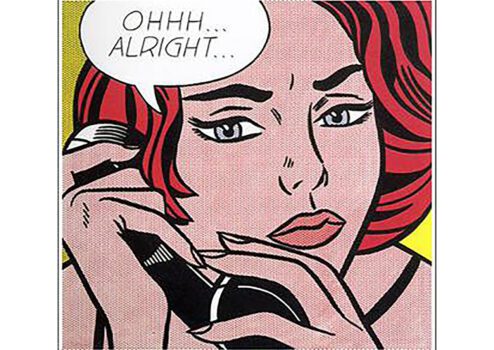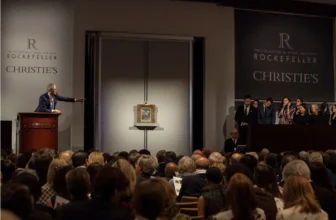Meaning of Roy Lichtenstein’s Ohhh…Alright Painting
In the pantheon of Pop Art, Roy Lichtenstein stands as a monumental figure who redefined the boundaries between high art and popular culture. Among his many celebrated works, Ohhh…Alright… (1964) remains one of the most emotionally charged, visually striking, and intellectually compelling paintings of the 20th century. At first glance, the painting seems deceptively simple, a cropped image of a woman on the phone, uttering the words “Ohhh…Alright…”, but beneath its comic book aesthetic lies a complex web of themes: desire, alienation, communication, and the commercialization of emotion.
This piece not only exemplifies the technical brilliance and cultural critique that define Lichtenstein’s oeuvre but also serves as a mirror to the American psyche during the tumultuous 1960s. In this comprehensive exploration, we’ll delve into what Ohhh…Alright… is all about, how it was painted, the deeper symbolism it holds, and where this iconic artwork resides today.
What is Ohhh…Alright… by Roy Lichtenstein All About?
At its core, Ohhh…Alright… is a poignant visual distillation of longing and unspoken emotion. The painting portrays a close-up of a red-haired woman speaking on the telephone. Her expression is sorrowful, pensive, perhaps frustrated, while her words, “Ohhh…Alright…”, suggest reluctant acquiescence, resignation, or emotional capitulation.
Lichtenstein’s subject seems caught in a moment of vulnerability. Her downward gaze and the tilt of her head evoke emotional distress or disappointment. The cropping of the image intensifies this sense of intimacy, trapping the viewer in a private, emotionally charged moment. Despite the glossy, clean comic-book style, there’s an unmistakable sadness behind her carefully drawn features.
The painting is quintessential Pop Art in form and tone, but it is also a reflection on the contradictions of mid-20th-century femininity: poised yet passive, glamorous yet powerless. It reflects how women were portrayed in mass media of the time, particularly romance comics, as beautiful but emotionally dependent figures, often waiting for or reacting to the actions of unseen male protagonists.
Who Painted Ohhh…Alright…, and How?
Ohhh…Alright… was painted in 1964 by Roy Lichtenstein, one of the foremost figures in the Pop Art movement. Born in 1923 in New York City, Lichtenstein came of age in a rapidly changing cultural and artistic landscape. Initially trained in traditional painting, his work took a radical turn in the early 1960s as he began to incorporate elements of commercial printing, advertising, and comic books into his art.
The process behind Ohhh…Alright… is both technical and conceptual. Lichtenstein would typically start by selecting a panel or frame from an actual comic book, often romance comics published in the 1950s and 1960s. For this particular work, he drew inspiration from Secret Hearts #88 (1963), a DC Comics romance series, modifying the source image extensively.
He would then transform this small, disposable, mass-printed comic panel into a monumental painting. Using oil and Magna (a fast-drying acrylic resin paint) on canvas, Lichtenstein meticulously recreated the original image with significant changes: simplifying lines, altering colors, and cropping the composition to enhance emotional focus. Most notably, he replicated the halftone printing technique of comic books using hand-painted Ben-Day dots, regularly spaced dots of color used in mass printing to create shading and texture.
Lichtenstein’s meticulous technique and his adaptation of industrial visual language were revolutionary. His goal wasn’t mere replication but rather reinterpretation: elevating the mundane into the monumental, and the commercial into the contemplative.
What is Happening in the Painting?
In Ohhh…Alright…, we witness an intimate emotional moment frozen in time. The painting captures a woman mid-conversation on the telephone with a romantic partner. The phrase “Ohhh…Alright…” can be read in many ways, reluctant agreement, suppressed anger, resignation, or disappointment. The ellipses before and after the phrase intensify its ambiguity, suggesting a pause filled with unspoken thoughts or emotions.
The woman’s facial expression is key: her furrowed brow, slightly parted lips, and downcast eyes suggest vulnerability, internal conflict, and perhaps emotional manipulation. Her carefully styled hair and makeup contrast with her emotional turmoil, further emphasizing the duality between appearance and feeling.
Importantly, the man on the other end of the line is absent. This absence creates a tension in the painting: the viewer is placed in his position, but instead of intimacy, there’s a barrier. We are distanced from her emotion by the stylized aesthetic, even as we’re drawn into the drama. This emotional ambiguity is what makes Ohhh…Alright… so compelling, it’s a narrative without resolution, a visual whisper of something much deeper.
Symbolism and Meaning of Ohhh…Alright…
The symbolism of Ohhh…Alright… is layered and multifaceted. At one level, it is a critique of mass media’s depiction of women, particularly the stereotypical roles assigned to women in mid-century romance comics. These comics often portrayed women as emotionally fragile, overly romantic, and dependent on male validation. By isolating and enlarging these portrayals, Lichtenstein exposes the formulaic and sometimes exploitative nature of such imagery.
Yet he doesn’t entirely dismiss them. There is also a degree of empathy in how he renders the woman’s face, capturing the depth of her emotion even through stylized lines and artificial color. She becomes a tragic figure, trapped not only in a moment of emotional vulnerability but also in a cultural system that commodifies such emotions.
The Ben-Day dots themselves also carry symbolic weight. Originally a technical limitation of cheap printing processes, Lichtenstein reappropriates them into the realm of high art. Their presence in the painting reminds the viewer of the mechanical reproduction at the heart of popular culture. But hand-painting these dots, painstakingly applying what was meant to be impersonal and mass-produced, adds a strange intimacy to the image. It’s a contradiction at the heart of the work: mechanical aesthetics serving an emotional narrative.
The cropping of the image also symbolizes fragmentation, of self, identity, and communication. The woman is not fully present; parts of her are missing from the frame. Similarly, her speech is incomplete, trailing off into ellipses. This speaks to the difficulty of genuine communication and the isolation that often accompanies it, even in seemingly connected moments like a phone call.
What Type of Art is Ohhh…Alright…?
Ohhh…Alright… is a quintessential example of Pop Art, a movement that emerged in the 1950s and gained prominence in the 1960s. Pop Art sought to challenge traditional fine art by incorporating imagery from popular and commercial culture, advertising, comic books, product packaging, and mass media.
Pop artists like Lichtenstein, Andy Warhol, and James Rosenquist questioned the hierarchy of “high” versus “low” culture. By appropriating everyday images and presenting them in a fine art context, they disrupted conventional notions of artistic value and originality.
In Lichtenstein’s case, his use of comic book panels wasn’t simply ironic or critical, it was analytical. He transformed these ephemeral, often overlooked images into enduring works of art, forcing viewers to reconsider their aesthetic and emotional power.
Formally, Ohhh…Alright… is characterized by:
Bold outlines and flat colors, typical of comic book art
Ben-Day dots, mimicking mass-printing techniques
Text integration, with speech bubbles or floating text
Cropped composition, heightening drama and emotional focus
But unlike the original comics, Lichtenstein’s work doesn’t tell a full story. The narrative is fragmented, ambiguous, and open-ended, qualities more aligned with modernist literature or cinema than with pulp fiction. This blend of pop aesthetics with deep psychological undercurrents is what gives Ohhh…Alright… its enduring significance.
Where is Ohhh…Alright… Today?
As of today, Ohhh…Alright… is in private hands. It made headlines in November 2010 when it was sold at Christie’s auction in New York for a staggering $42.6 million, setting a then-record for a work by Lichtenstein. The buyer, whose identity was not disclosed publicly, is believed to be a private collector. The painting’s high valuation reflects both its aesthetic power and its cultural importance.
Although privately owned, Ohhh…Alright… has been displayed in major exhibitions at institutions like the Art Institute of Chicago, Tate Modern, and the Whitney Museum of American Art during retrospective tours. When it appears in exhibitions, it is often featured as a centerpiece of Lichtenstein’s 1960s work, emblematic of both his technical prowess and his cultural critique.
Cultural Impact
Ohhh…Alright… is more than just a painting; it is a cultural artifact. It represents a moment when art was redefined, when the sacred borders of oil painting were infiltrated by the mundane visuals of the everyday. It also remains a powerful commentary on gender roles, emotional performance, and the commercialization of sentiment.
In today’s age of social media, where emotions are often curated for public consumption, Ohhh…Alright… feels eerily prophetic. The woman’s expression, at once intimate and performative, resonates with the emotional ambiguity of modern digital communication. Her stylized sadness is not unlike the filtered portrayals of vulnerability that populate Instagram and TikTok.
Contemporary artists continue to be influenced by Lichtenstein’s work. From Jeff Koons to Takashi Murakami, many have drawn on his exploration of media, repetition, and consumerism. But few have captured the bittersweet poetry of the human condition quite like Lichtenstein did in Ohhh…Alright….
Roy Lichtenstein’s Ohhh…Alright… is a masterpiece that transcends its Pop Art origins. Through a seemingly simple image borrowed from a comic book, it opens up complex conversations about gender, communication, emotional commodification, and the role of art in society. The painting stands as both a product of its time and a timeless commentary on how we express and experience emotion.
Its enduring appeal lies in this very tension: it is both impersonal and intimate, commercial and artistic, superficial and profound. In Ohhh…Alright…, Lichtenstein didn’t just capture a moment, he captured a feeling, an aesthetic, and a cultural critique that continues to resonate today.




